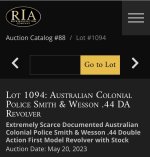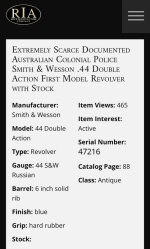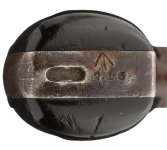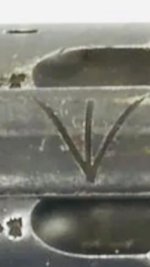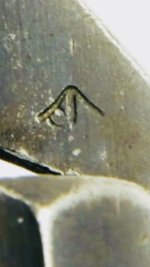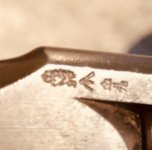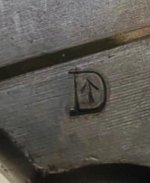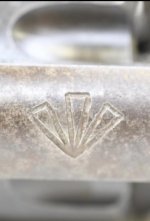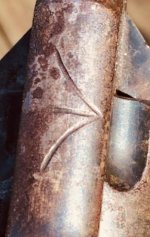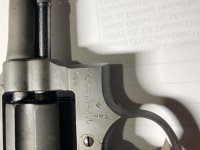Aussie Collector
Member
"Extremely Scarce Documented Australian Colonial Police Smith & Wesson .44 Double Action First Model Revolver with Stock".
Looking at this item at a recent RIA auction I was excited, something S&W in Australia I was not aware of. Something I had to now look for, the more I read the more questions I had.
The names mentioned are very knowledgeable and well respected authorities in things S&W. No offence is meant to anyone involved, my comments and thoughts could be completely incorrect. I would be very happy to be on the wrong track.
Looking at the 44DA.
The 44DA in question is said to have shipped from S&W 28th February 1905 to a US distributor. Obviously arriving in Australia some time after this for the story to gel.
The shoulder stock cut is not factory this is quite obvious.
The broad arrow or "pheon" stamp is a British Commonwealth stamp. Australian NM#3s purchased by the South Australian Police (S.A.P.) were given this stamp. The stamp on the 44DA appears different. Possibly it's the photo, lighting and or angle. It appears to me to be made of three different strikes. You could expect variations on the broad arrow stamping however there was a standard for these stamps and they vary very little.
Possible purchase by colonial police?
The purchase of firearms for police in Australia differs to the US. Firearm are purchased at a State or Territory level. A document trail still exists for most of these purchases. There are no records that I'm aware of that show a 44DA being purchased by S.A.P. I say S.A.P. because they purchased the bulk of the NM#3s with shoulder stocks that came into Australia and retained most of them to 1954. Only the shoulder stocks that went to the S.A.P. were stamped with the broad Arrow. And only the S.A.P. shoulder stocks were stamped with NM#3 serial numbers.
The shoulder stock sold with this 44DA is from the South Australian police stocks. Records indicate NM#3 serial number 13020 was sold in 1954 to a US dealer. Presumably the stock was with the guns sold however it might not have been.
Possibly this 44DA was a private purchase in Australia? Purchased by a private individual or a policeman as a private gun.
Around the birth of this gun the South Australian mounted police were still using the S&W NM#3s. Foot patrol were issued with Adams revolvers with a few police, not liking the Adams, using privately owned guns. In 1909 S.A.P. purchased Webley & Scott revolvers for the foot patrol police.
Therefore between 1905 and 1909 it's very possible that the 44DA could have been a private purchase. And after the Webley revolvers and later the Webley & Scott semi-autos it's still possible a S.A.P officer purchased this 44DA as a private gun. This would however not account for the broad arrow as pivate guns were not stamped.
The shoulder stock is numbered to the new model number 3s shipped to South Australian police in 1882. The stocks were stamped with the guns serial number by the South Australian Police. The NM#3s remained in service into the early 1950s. Except for the few sold to Northern Territory police the NM#3 revolvers and shoulder stocks remained in the hands of the S.A.P. up to 1954 when they were sold.
S.A.P. retained a complete record listing all the NM#3s serial numbers held and sold in 1954. There is no mention of a 44DA in the register of sales with the NM#3s.
If the 44DA was used by Western Australia Police then there would not be a broad arrow stamp.
The Western Australian police purchased some of the NM#3s and a few were sold to the public in the late1880s by the Australian retailer.
Western Australian police guns were not stamped and most are reported as distroyed. I have one example of a western Australian NM#3 in my possession and it's not stamped with the broad arrow.
Northern territory police also had a few NM#3s which were purchased from the S.A.P. in 1911 when the territory went from South Australian control to Commonwealth. It's possible this 44DA was adapted in Northern territory.
I have many books on Australian police guns, South Australian (max slees book some of you may know) NSW, Victoria, and others covering colonial Australia and police firearms. None of these books mention a S&W 44DA that I recall.
"Extremely Scarce Documented"
Looking at these documents
1 - A letter written to the chief of police in Ballarat, New South Wales.
Ballarat is not in the state of New South Wales, Ballarat is in Victoria. In Australia we do not use the title "chief of police". semantics? maybe?
Im interested in the responce letter as I think it would be more important.
2 - A letter from the Australian dealer confirming Australian Police use of the .44 DA.
I would like to know who the Australian dealer mentioned who confirmed the Australian police use of this gun. I would talk to this dealer directly. What proof or documents was given or used to back up the claim it was it an opinion?
3- 1993 notarized letter from previous owner C.D.R.
Ballarat mentioned in the letter is not in NSW, as mentioned above, Ballarat is located in central Victoria.
The Ballarat airport in the 1959/1960 period was controlled by the RAAF (Royal Australian Air Force) and not used for freight.
All this means is C.D.R most likely did not fly into Ballarat. The nearest operating airport for freight at that time would have been in Melbourne some 2 hours drive.
As written above, police firearms are purchased at a State or Territory level. They are also sold at that level, not on a local level or at a local municipal sale. If the gun was purchased at a Ballarat sale then it was from private ownership.
The letter indicates the writer believes the 44DA shoulder stock set is factory. Clearly it's not. The stock came from the NM#3s and the 44DA stock cutout was done after the gun left the factory.
4 - 1993 letter, firearms collector and dealer O.C. Young acquired the gun from C.D.R.
No comment as I have not seen this letter
5 - statement from S&W historian Roy Jinks.
The letter states Marcus Hartley Co. of New York City received this DA44 shipped to them on February 28th 1905. Interestingly Marcus Hartley Co. did export firearms to Australia. Looking at records of sent firearms I could not find any evidence of any S&W firearms in the 1905 or 1906 shipment records of firearms sent to Australia by Marcus Hartley co. I could not find any shipments to Australia after 1906 from Marcus Hartley co.
Advanced Australian collectors mentioned in the write-up. I know a few of the advanced Australian collectors and do not know of anyone knowing of a 44DA being used by colonial police. Or have I seen one in the collections viewed over the years.
This one has so many questions around it. I would like to know more and would certainly like one of the "few known" examples although my personal opinion is there may be only one.
Did the writer of the auction item have doubts also? In the write up on this 44DA is the sentence..."Purportedly these .44 DA revolvers were adapted in Australia with a New Model No. 3 stock." The meaning for the word "Purportedly" is - is as appears or is stated to be true, though not necessarily so.
Regardless of the true history of this 44DA it's an interesting one. What are your thoughts?
Looking at this item at a recent RIA auction I was excited, something S&W in Australia I was not aware of. Something I had to now look for, the more I read the more questions I had.
The names mentioned are very knowledgeable and well respected authorities in things S&W. No offence is meant to anyone involved, my comments and thoughts could be completely incorrect. I would be very happy to be on the wrong track.
Looking at the 44DA.
The 44DA in question is said to have shipped from S&W 28th February 1905 to a US distributor. Obviously arriving in Australia some time after this for the story to gel.
The shoulder stock cut is not factory this is quite obvious.
The broad arrow or "pheon" stamp is a British Commonwealth stamp. Australian NM#3s purchased by the South Australian Police (S.A.P.) were given this stamp. The stamp on the 44DA appears different. Possibly it's the photo, lighting and or angle. It appears to me to be made of three different strikes. You could expect variations on the broad arrow stamping however there was a standard for these stamps and they vary very little.
Possible purchase by colonial police?
The purchase of firearms for police in Australia differs to the US. Firearm are purchased at a State or Territory level. A document trail still exists for most of these purchases. There are no records that I'm aware of that show a 44DA being purchased by S.A.P. I say S.A.P. because they purchased the bulk of the NM#3s with shoulder stocks that came into Australia and retained most of them to 1954. Only the shoulder stocks that went to the S.A.P. were stamped with the broad Arrow. And only the S.A.P. shoulder stocks were stamped with NM#3 serial numbers.
The shoulder stock sold with this 44DA is from the South Australian police stocks. Records indicate NM#3 serial number 13020 was sold in 1954 to a US dealer. Presumably the stock was with the guns sold however it might not have been.
Possibly this 44DA was a private purchase in Australia? Purchased by a private individual or a policeman as a private gun.
Around the birth of this gun the South Australian mounted police were still using the S&W NM#3s. Foot patrol were issued with Adams revolvers with a few police, not liking the Adams, using privately owned guns. In 1909 S.A.P. purchased Webley & Scott revolvers for the foot patrol police.
Therefore between 1905 and 1909 it's very possible that the 44DA could have been a private purchase. And after the Webley revolvers and later the Webley & Scott semi-autos it's still possible a S.A.P officer purchased this 44DA as a private gun. This would however not account for the broad arrow as pivate guns were not stamped.
The shoulder stock is numbered to the new model number 3s shipped to South Australian police in 1882. The stocks were stamped with the guns serial number by the South Australian Police. The NM#3s remained in service into the early 1950s. Except for the few sold to Northern Territory police the NM#3 revolvers and shoulder stocks remained in the hands of the S.A.P. up to 1954 when they were sold.
S.A.P. retained a complete record listing all the NM#3s serial numbers held and sold in 1954. There is no mention of a 44DA in the register of sales with the NM#3s.
If the 44DA was used by Western Australia Police then there would not be a broad arrow stamp.
The Western Australian police purchased some of the NM#3s and a few were sold to the public in the late1880s by the Australian retailer.
Western Australian police guns were not stamped and most are reported as distroyed. I have one example of a western Australian NM#3 in my possession and it's not stamped with the broad arrow.
Northern territory police also had a few NM#3s which were purchased from the S.A.P. in 1911 when the territory went from South Australian control to Commonwealth. It's possible this 44DA was adapted in Northern territory.
I have many books on Australian police guns, South Australian (max slees book some of you may know) NSW, Victoria, and others covering colonial Australia and police firearms. None of these books mention a S&W 44DA that I recall.
"Extremely Scarce Documented"
Looking at these documents
1 - A letter written to the chief of police in Ballarat, New South Wales.
Ballarat is not in the state of New South Wales, Ballarat is in Victoria. In Australia we do not use the title "chief of police". semantics? maybe?
Im interested in the responce letter as I think it would be more important.
2 - A letter from the Australian dealer confirming Australian Police use of the .44 DA.
I would like to know who the Australian dealer mentioned who confirmed the Australian police use of this gun. I would talk to this dealer directly. What proof or documents was given or used to back up the claim it was it an opinion?
3- 1993 notarized letter from previous owner C.D.R.
Ballarat mentioned in the letter is not in NSW, as mentioned above, Ballarat is located in central Victoria.
The Ballarat airport in the 1959/1960 period was controlled by the RAAF (Royal Australian Air Force) and not used for freight.
All this means is C.D.R most likely did not fly into Ballarat. The nearest operating airport for freight at that time would have been in Melbourne some 2 hours drive.
As written above, police firearms are purchased at a State or Territory level. They are also sold at that level, not on a local level or at a local municipal sale. If the gun was purchased at a Ballarat sale then it was from private ownership.
The letter indicates the writer believes the 44DA shoulder stock set is factory. Clearly it's not. The stock came from the NM#3s and the 44DA stock cutout was done after the gun left the factory.
4 - 1993 letter, firearms collector and dealer O.C. Young acquired the gun from C.D.R.
No comment as I have not seen this letter
5 - statement from S&W historian Roy Jinks.
The letter states Marcus Hartley Co. of New York City received this DA44 shipped to them on February 28th 1905. Interestingly Marcus Hartley Co. did export firearms to Australia. Looking at records of sent firearms I could not find any evidence of any S&W firearms in the 1905 or 1906 shipment records of firearms sent to Australia by Marcus Hartley co. I could not find any shipments to Australia after 1906 from Marcus Hartley co.
Advanced Australian collectors mentioned in the write-up. I know a few of the advanced Australian collectors and do not know of anyone knowing of a 44DA being used by colonial police. Or have I seen one in the collections viewed over the years.
This one has so many questions around it. I would like to know more and would certainly like one of the "few known" examples although my personal opinion is there may be only one.
Did the writer of the auction item have doubts also? In the write up on this 44DA is the sentence..."Purportedly these .44 DA revolvers were adapted in Australia with a New Model No. 3 stock." The meaning for the word "Purportedly" is - is as appears or is stated to be true, though not necessarily so.
Regardless of the true history of this 44DA it's an interesting one. What are your thoughts?

